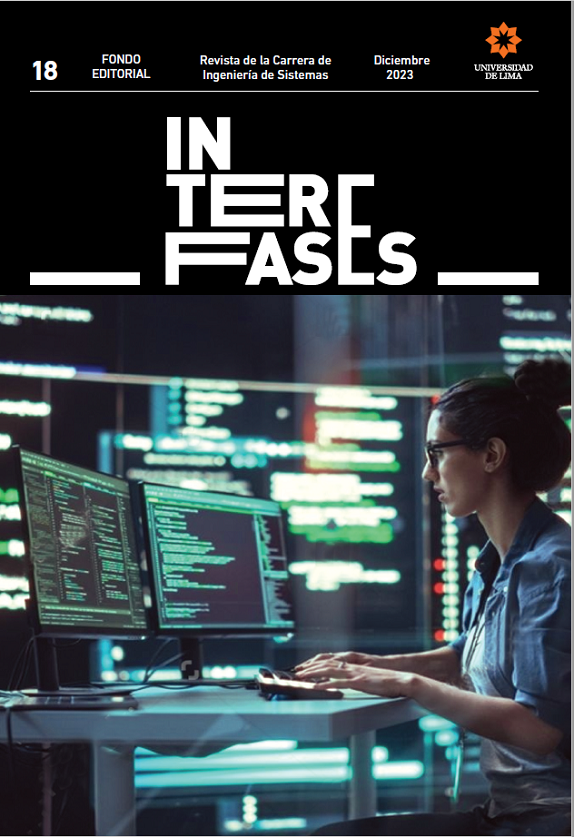Prueba de concepto de interfaz touchless en teclado numérico aleatorio para mitigación de shoulder surfing en cajeros automáticos
DOI:
https://doi.org/10.26439/interfases2023.n018.6557Palabras clave:
interfaces touchless, cajeros automáticos, shoulder surfing, teclado numérico aleatorioResumen
La inclusión financiera en el Perú está en aumento, pues ya el 56 % de los adultos tiene productos financieros. Esto ha incrementado el uso de cajeros automáticos y los riesgos asociados a ellos, como el shoulder surfing. Buscando mitigar el riesgo de este ataque, se hizo una prueba de concepto de interfaz touchless que permite a los usuarios ingresar su PIN de manera segura, proponiendo un ejemplo para que sea usado por entidades bancarias o fabricantes de cajeros automáticos. Para esto, se generaron secuencias desordenadas aleatoriamente con los números del 0 al 9 sin que estos se repitan. Luego, se implementan sensores infrarrojos para ingresar los números del PIN. Se realizaron pruebas de mitigación y usabilidad con un grupo de 16 personas. La primera prueba mostró resultados alentadores, pues a los atacantes se le dificulta identificar los dígitos ingresados por los usuarios y solo lograron registrar el 25 % correctamente. Asimismo, en las pruebas de usabilidad se obtuvo un promedio general de usabilidad de 78.4375, situando a la interfaz en un rango B +, por encima del umbral de 68 puntos. Considerando esto, se concluye que la propuesta cumple con el objetivo de permitir al usuario ingresar su PIN de manera segura ante ataques de shoulder surfing.
Descargas
Referencias
Abhishek, K., Verma Kumar, M., & Prasad Singh, M. (2019). Automated random colour keypad. International Journal of Information and Communication Technology, 15(2), 162-175. https://doi.org/10.1504/IJICT.2019.10018383
Adithya, P., Aishwarya, S., Megalai, S., Priyadharshini, S., & Kurinjimalar, R. (2018). Security enhancement in automated teller machine. Proceedings of 2017 International Conference on Intelligent Computing and Control, I2C2 2017, 2018-January. https://doi.org/10.1109/I2C2.2017.8321773
Agarwal, M., Mehra, M., Pawar, R., & Shah, D. (2011). Secure authentication using dynamic virtual keyboard layout. International Conference and Workshop on Emerging Trends in Technology 2011, ICWET 2011 - Conference Proceedings, Icwet, 288-291. https://doi.org/10.1145/1980022.1980087
Ahmad, A. G. (2013). Arduino as a learning tool. Sensing Technologies for Global Health, Military Medicine, and Environmental Monitoring III, 8723, 872313.
Alsuhibany, S. A. (2021). A Camouflage Text-Based Password Approach for Mobile Devices against Shoulder-Surfing Attack. Security and Communication Networks. https://doi.org/10.1155/2021/6653076
Borsci, S., Federici, S., Bacci, S., Gnaldi, M., & Bartolucci, F. (2015). Assessing user satisfaction in the era of user experience: Comparison of the SUS, UMUX, and UMUX-LITE as a function of product experience. International Journal of Human-Computer Interaction, 31(8), 484-495. https://doi.org/10.1080/10447318.2015.1064648
Bultel, X., Dreier, J., Giraud, M., Izaute, M., Kheyrkhah, T., Lafourcade, P., Lakhzoum, D., Marlin, V., & Motá, L. (2018). Security analysis and psychological study of authentication methods with PIN codes. Proceedings - International Conference on Research Challenges in Information Science, 2018-May, 1-11. https://doi.org/10.1109/RCIS.2018.8406648
Chakraborty, T., Nasim, M., Bin Malek, S. M., Sami, M. T. H. M., Saeef, M. S., & Al Islam, A. B. M. A. (2016). Sporshohin: A tale of devising visible light based low-cost robust touchless input device. Proceedings of the 7th Annual Symposium on Computing for Development, ACM DEV-7 2016. https://doi.org/10.1145/3001913.3001914
Edem Udo Udo, E., Abiso Kabir, A., Yusuff, A. M., & Bukola Simeon, A. (2017). Impact of automated teller machine on customer satisfaction and profitability of commercial banks. IIARD International Journal of Banking and Finance Research, 3(2). http://www.iiardpub.org
Ipsos. (2019, 14 de octubre). Hay 400,000 que sufrieron algún tipo de robo o fraude financiero. Ipsos. https://www.ipsos.com/sites/default/files/ct/publication/documents/2019-10/hay_400000_que_sufrieron_algun_tipo_de_robo_o_fraude_financiero.pdf
Lewis, J. R. (2018). Measuring perceived usability: The CSUQ, SUS, and UMUX. International Journal of Human-Computer Interaction, 34(12), 1148-1156. https://doi.org/10.1080/10447318.2017.1418805
Lewis, J. R., Utesch, B. S., & Maher, D. E. (2013). UMUX-LITE - When there’s no time for the SUS. Conference on Human Factors in Computing Systems - Proceedings, October, 2099-2102. https://doi.org/10.1145/2470654.2481287
Maiti, A., Jadliwala, M., & Weber, C. (2017). Preventing shoulder surfing using randomized augmented reality keyboards. 2017 IEEE International Conference on Pervasive Computing and Communications Workshops, PerCom Workshops 2017, 630-635. https://doi.org/10.1109/PERCOMW.2017.7917636
Montanaro, L., Sernani, P., Dragoni, A. F., & Calvaresi, D. (2016). A touchless human-machine interface for the control of an elevator. CEUR Workshop Proceedings, 1746, 58-65.
Rajarajan, S., Maheswari, K., Hemapriya, R., & Sriharilakshmi, S. (2014). Shoulder surfing resistant virtual keyboard for internet banking. World Applied Sciences Journal, 31(7), 1297-1304. https://doi.org/10.5829/idosi.wasj.2014.31.07.378
Roth, V., Richter, K., & Freidinger, R. (2004). A PIN-entry method resilient against shoulder surfing. Proceedings of the ACM Conference on Computer and Communications Security, 236-245. https://doi.org/10.1145/1030083.1030116
Sevilla-Gonzalez, M. D. R., Moreno Loaeza, L., Lazaro-Carrera, L. S., Bourguet Ramirez, B., Vázquez Rodríguez, A., Peralta-Pedrero, M. L., & Almeda-Valdes, P. (2020). Spanish version of the system usability scale for the assessment of electronic tools: Development and validation. JMIR Human Factors, 7(4), e21161. https://doi.org/10.2196/21161
Shukla, S., Helonde, A., Raut, S., Salode, S., & Zade, J. (2018). Random keypad and face recognition authentication mechanism. IRJET, 5(3), 3685–3688.
Statista. (2023a). Number of automated teller machines (ATMs) per 100,000 adults in Peru from 2005 to 2021. https://www.statista.com/statistics/1079224/peru-automated-teller-machines-atm-penetration/
Statista. (2023b). Number of ATM transactions in selected countries in Latin America in 2019. https://www.statista.com/statistics/823923/number-atm-transactions-latin-america-country/
Still, J. D., & Bell, J. (2018). Incognito: Shoulder-surfing resistant selection method. Journal of Information Security and Applications, 40, 1-8. https://doi.org/10.1016/j.jisa.2018.02.006
Superintendencia de Banca y Seguros y AFP. (2020). Perú: indicadores de inclusión financiera de los sistemas financieros, de seguros y de pensiones - junio 2020. https://intranet2.sbs.gob.pe/estadistica/financiera/2020/Junio/CIIF-0001-jn2020.PDF
Toledo Concha, E., & León Reyes, V. (2023). Financial inclusion in Peru: Appraisal and perspectives. Quipukamayoc, 31(65), 73-84. https://doi.org/10.15381/quipu.v31i65.25882
Yu, M., Zhuge, J., Cao, M., Shi, Z., & Jiang, L. (2020). A survey of security vulnerability analysis, discovery, detection, and mitigation on IoT devices. Future Internet, 12(2), 1-23. https://doi.org/10.3390/fi12020027
Publicado
Número
Sección
Licencia
Los autores/as que publiquen en esta revista aceptan las siguientes condiciones:
Los autores/as conservan los derechos de autor y ceden a la revista el derecho de la primera publicación, con el trabajo registrado con la licencia de atribución de Creative Commons, que permite a terceros utilizar lo publicado siempre que mencionen la autoría del trabajo y a la primera publicación en esta revista.
Los autores/as pueden realizar otros acuerdos contractuales independientes y adicionales para la distribución no exclusiva de la versión del artículo publicado en esta revista (p. ej., incluirlo en un repositorio institucional o publicarlo en un libro) siempre que indiquen claramente que el trabajo se publicó por primera vez en esta revista.
Se permite y recomienda a los autores/as a publicar su trabajo en Internet (por ejemplo en páginas institucionales o personales) antes y durante el proceso de revisión y publicación, ya que puede conducir a intercambios productivos y a una mayor y más rápida difusión del trabajo publicado (vea The Effect of Open Access).
Última actualización: 03/05/21






